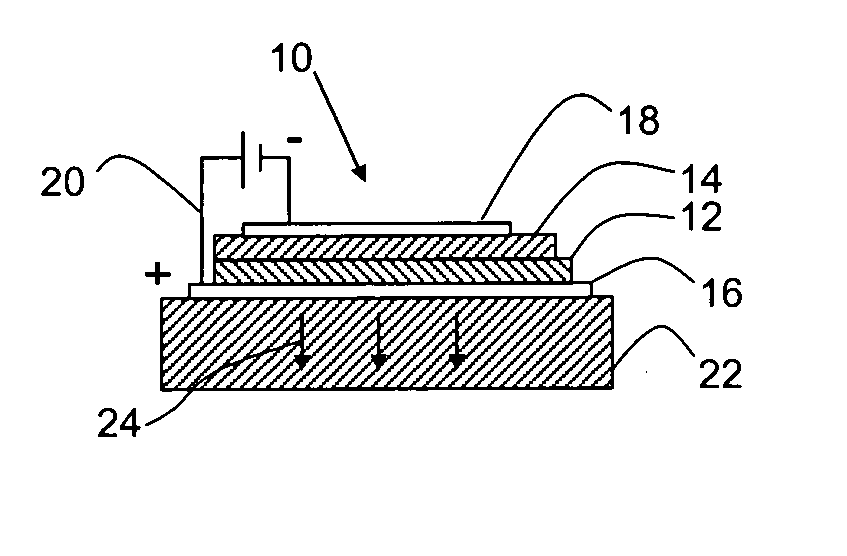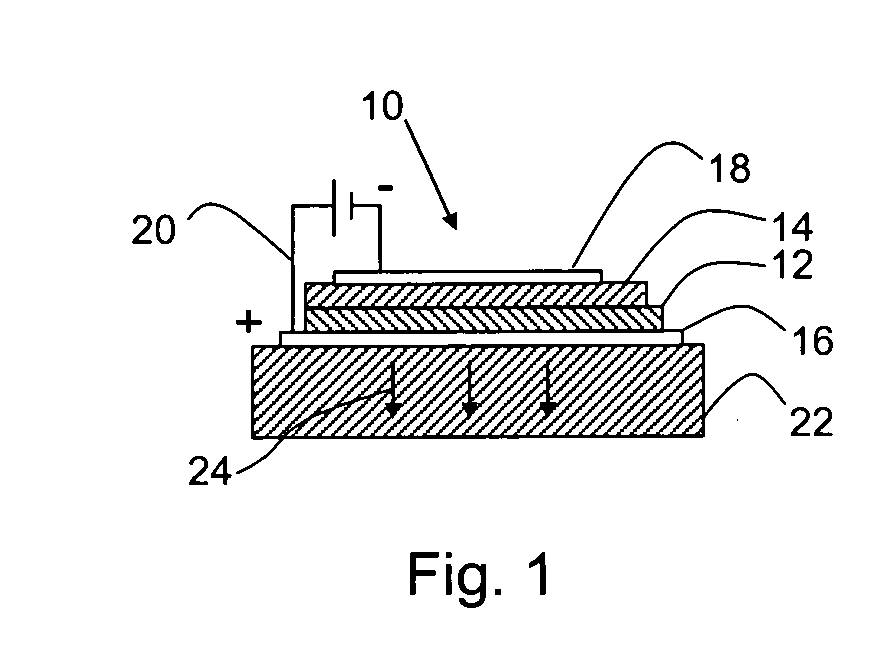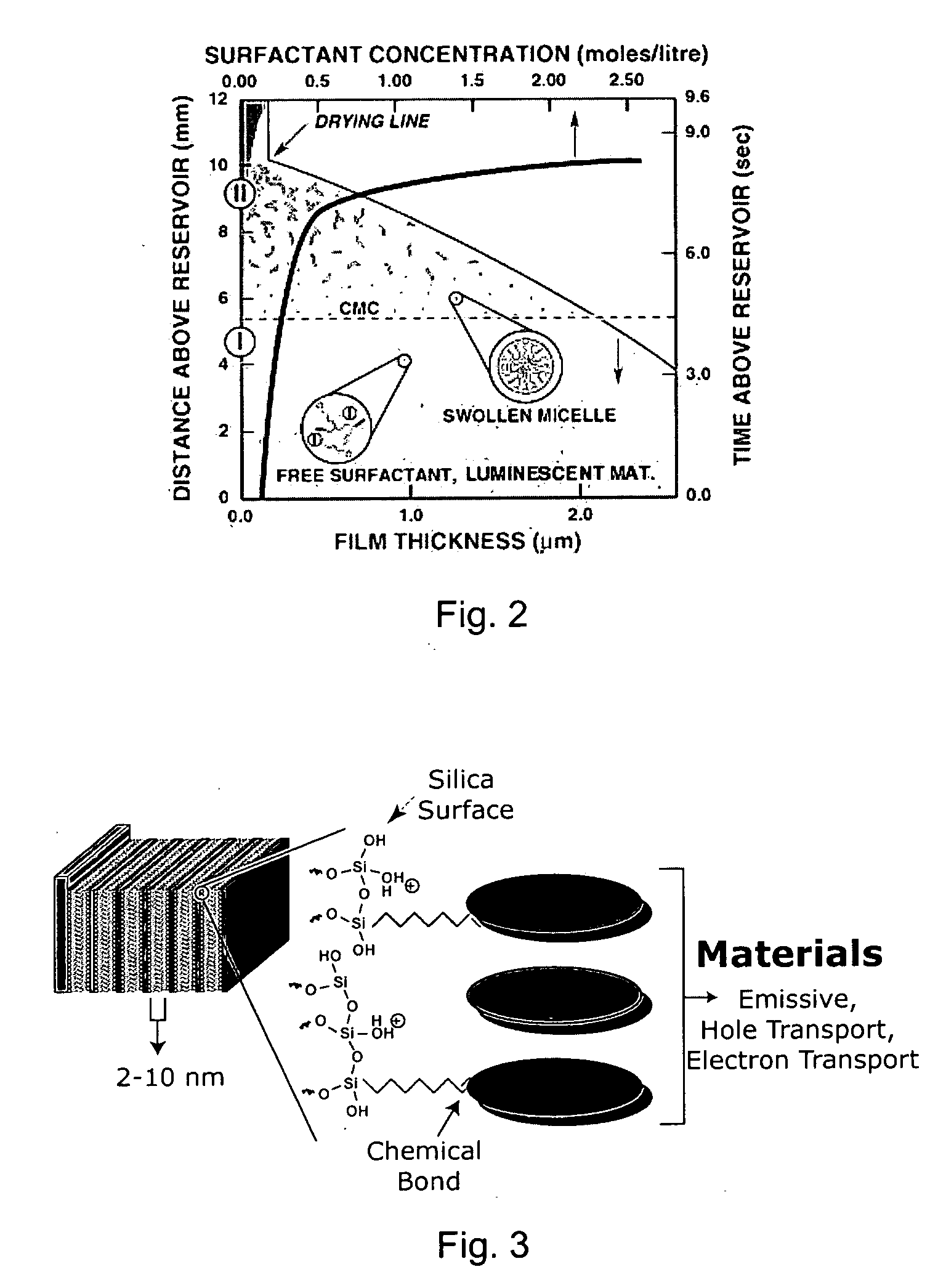Self-assembly of organic-inorganic nanocomposite thin films for use in hybrid organic light emitting devices (HLED)
- Summary
- Abstract
- Description
- Claims
- Application Information
AI Technical Summary
Benefits of technology
Problems solved by technology
Method used
Image
Examples
example 1
The initial silica precursor stock solution is prepared by refluxing TEOS (120 mL) [Si(OCH2CH3)4], THF (120 mL), water (9.8 mL), and 0.07N HCl (0.4 mL) at 60° C. for 90 minutes. This solution can be stored at −20° C. for 1 year. The acid concentration and reaction time are adjusted so as to minimize the size and condensation rate of the silica species. THF may also be replaced by ethanol, methanol, isopropanol, and aprotic solvents, such as diethylether, dioxane, N,N-dimethylformamide (DMF), N,N-dimethylacetamide (DMAC), N-methylpyrrolidone (NMP), dimethyl sulfoxide (DMSO), and acetone.
example 2
A portion of the silica precursor solution from Example 1 (17 mL) is diluted with THF (20 mL), followed by addition of water (0.7mL), 0.07N HCl (2.1 mL) and cetyltrimethylammonium bromide (CTAB, surfactant, 1.7 g). A hole transport material, N4′-(9,9-dimethyl-9H-fluoren-2-yl)-N4-(9,9-dimethyl-9H-fluoren-3-yl)-N4-phenyl-N4′-[4-(vinyltriethoxysilyl)-phenyl]-biphenyl-4,4′-diamine, (shown below, 1 g) dissolved in 20 mL THF is added to the solution with stirring followed by addition of 7-octenyltrimethoxysilane (silica coupling agent, 0.5 g).
N4′-(9,9-dimethyl-9H-fluoren-2-yl)-N4-(9,9-dimethyl-9H-fluoren-3-yl)-N4-phenyl-N4′-[4-(vinyltriethoxysilyl)-phenyl]-biphenyl-4,4′-diamine
The solution is stirred for 30 minutes. This solution is used immediately for deposition of thin films or stored at −20° C. where it is stable for up to 1 year.
example 3
A solution is prepared according to the procedure of Example 2, except the hole transport material is replaced by an electron transport material, 2-naphthalen-1-yl-5-[4-(3,3,3-vinyltriethoxysilyl)-phenyl]-[1,3,4]oxadiazole, (1 g), shown below.
2-naphthalen-1-yl-5-[4-(3,3,3-vinyltriethoxysilyl)-phenyl]-[1,3,4]oxadiazole
PUM
| Property | Measurement | Unit |
|---|---|---|
| Transparency | aaaaa | aaaaa |
| Transport properties | aaaaa | aaaaa |
| Luminescence | aaaaa | aaaaa |
Abstract
Description
Claims
Application Information
 Login to View More
Login to View More - R&D
- Intellectual Property
- Life Sciences
- Materials
- Tech Scout
- Unparalleled Data Quality
- Higher Quality Content
- 60% Fewer Hallucinations
Browse by: Latest US Patents, China's latest patents, Technical Efficacy Thesaurus, Application Domain, Technology Topic, Popular Technical Reports.
© 2025 PatSnap. All rights reserved.Legal|Privacy policy|Modern Slavery Act Transparency Statement|Sitemap|About US| Contact US: help@patsnap.com



